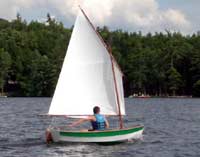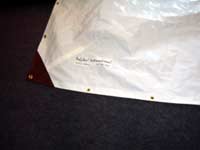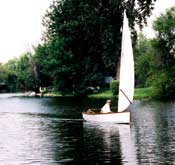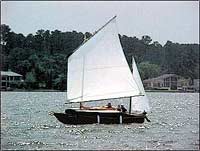|
Polysails - The Sheet Sail
Alternative |

|
| By Dave Gray - Indianapolis,
Indiana - USA |
Novice sailboat builders often find themselves in
a quandary once their plans actually go 3-D. A quality
sail for their new craft invariably costs much more
than expected and often exceeds their investment in
their newly completed hulls. Invariably, these newbie
builders begin seeking advice and alternatives on
the Internet, and chances are high that they will
eventually encounter other builders or web sites where
they will learn about polytarp sails, a polyethylene
sail made from a lowly, but inexpensive, tarp.
 |
Ray Hodsdons
beautiful little shellback dinghy underway
powered by a PolySail. Ray, who formerly
sailed 18’ Hobie Cats, provided
a very positive testimonial on his polysail's
performance.
(click
images to enlarge) |
|
A few years back, the tarp-equipped sailboat would
have been easy to spot. The homemade blue or green
sail flopping in the wind was a dead giveaway. The
irrepressible Captain Freddie, who sailed his fiberglass
cruiser equipped with blue tarp sails from Massachusetts
to Florida is something of a cult hero to the tarp
sail crowd. A follow up article in Soundings a few
years ago found Freddie in Rhode Island writing a
book about his adventures. (There is a photo located
HERE.
Over the past few years, however, a heavier white
polytarp material has made spotting tarp sails much
more difficult.
Popularized by PolySail
International, a garage-based, part-time
business offering white polytarp sails in inexpensive
kit form, PolySails now appear on smaller home built
boats around the world. Over 500 of these kits have
been sold over the last ten years. Kits have been
mailed to all 50 US states, and numerous foreign countries,
including Australia, Canada, England, France, Greece,
Italy, Ireland, New Zealand, the Philippines, and
Thailand. A few of the white polytarp powered sailboats
have even appeared in the builder’s photo section
of Wooden Boat magazine.
|
|
Spiros
Mamais of Athens, Greece built a lug sail
for his homebuilt craft from a PolySail
Kit. |
|
What are PolySails? These are sails constructed from
three ply white polytarp material imported from factories
located in China, India, Pakistan, and South Korea,
and other Pacific Rim countries. The tarp’s
center layer is created of polyethylene strips in
a 12 x 12 or 14 x 14 weave per square inch. This center
layer is bonded on both sides by flat sheets of the
same material, creating a plastic-like material about
12 mils in thickness and weighing between 5 and 6
ounces per sq. yard (not a sailmaker’s yard).
Occasionally, the material can be found in “canopy
grade” weighing about 8 ounces per square yard.
Compared to the common blue tarps which weigh about
3 ounces per square yard, usually have a 6 x 10 weave,
and lack the ultraviolet protection of the white tarps,
the white polytarps have less stretch and are considerably
more durable. Up close, the plastic-like surface,
the lack of sailmaker’s seams, and the characteristic
wrinkles in the material distinguish the PolySail
material from more traditional sail materials. To
prove the material’s strength, I have suspended
a 10’ x 12’ tarp in the air and stood
in the middle of it. I weigh about 190 pounds.
Because PolySails are made from a single sheet of
material, they usually depend on edge rounding and
a dart or two to define their shape. Shape is also
aided by the manufacturing process which uses heat
and pressure to “weld” doubled edges and
lapped seams into the material. This process shrinks
the edges and seams and allows some stretch in the
tarp’s interior. To make a PolySail, a builder
uses double-faced tape to create the sail outline.
After removing the tape backing, a reinforcing line
is run around the interior of the tape. Afterwards,
the exposed tape edges are lapped back over the line,
creating the sail type of the builder’s choice.
A taped and grommeted sail made to my directions,
usually takes about 4 hours to complete and will last
about a season before the tapes used in construction
begin to lose adhesion and a stitch must be run around
the perimeter of the sail to preserve it.
This photo
shows the finished tack in a Weekender gaff
sail. Note the dart, the use of the
“welded” tarp seam material,
and the application of the vinyl tape to
reinforce the corner.
|

|
|
Nearly every type of sail has been made from white
polytarp over the past few years, primarily for smaller
boats up to 16 feet in length. Favorites seem to be
the 60 square foot leg o’ mutton sail used by
designer Phil Bolger on a number of his small boats
and the Weekender gaff and jib for a small cruiser
designed by Stevenson Projects. We have surveyed our
customers over the years, and about half these amateur
sailbuilders report performance equal to other synthetic
sails, such as Dacron, constructed in traditional
sailmaking fashion by professional sailmakers. However,
as one customer pointed out, there were other factors
besides performance that were involved when comparing
an inexpensive PolySail to a commercially made sail
that cost nine times as much.
Typically, PolySails are used in protected waters
in light winds, although there is one report of a
PolySail surviving a tornado with minimal damage.
Three years of surveys with response rates approaching
40% have shown customers to be overwhelmingly positive
about their kits and finished sails.
 |
Me sailing
my 16’ sharpie "Essence"
down a channel near my home. "Essence"
sports a jib-headed, sprit-boomed PolySail. |
|
In ten years only one customer has ever reported
a material failure in a PolySail. However, when we
offered a replacement kit, the customer blamed himself
for the failure rather than the material. More survey
details and PolySail research are available HERE.
Given the positive results for the customer-constructed
kits, Gray has recently started producing ready-made
sails for some popular boats and custom sails for
others. He anticipates continued growth for his PolySails
and kits as the sails appear on boats across the country
and as the media begins to report on their quality
and performance. While he doesn’t anticipate
immediate acceptance by some of the more tradition-bound
sailing clubs and media, he predicts that price and
performance will continue to drive growth with the
less well-to-do sailors and with home builders. Kits
and sails are currently available from PolySail International,
complete with shipping, in a range from about $60
to $200.
| Chuck and
Sandra Leinweber, owners of the online Duckworks
Magazine and the Duckworks Store, put their
Jim Michalak-designed Caprice through its
paces. With a LOA of 22’ and an estimated
weight of 3000 pounds, this boat is one
of the larger home-built boats known to
have carried a PolySail |

|
|

More articles about Polysails:
|